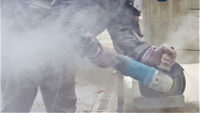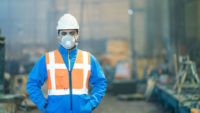The recent pandemic has affected construction sites across America. Personal protective equipment (PPE) has become more critical than ever — especially respirators and disposable gloves. COVID-19 has forced many projects to revisit their PPE assessment.
As positivity rates change, employers need to monitor these PPE selections. Five other types of PPE also require frequent evaluations to ensure workers remain protected from jobsite hazards:
- Respiratory protection,
- Hearing protection,
- FR clothing,
- Eye protection, and
- Footwear.
If your project PPE assessment isn’t updated regularly, your workers can be left without adequate protections — exposing them to injuries.
Examples of hazards to include in your assessment while performing a walk-through survey of your jobsite include:
- Motion (i.e., moving equipment or tools that could result in a pinch point between a workers hand and a stationary object);
- High temperatures that could result in burns, eye injury, or ignition of protective equipment;
- Chemical exposures;
- Harmful dust;
- Light radiation (i.e., welding, brazing, cutting, heat treating, and high-intensity lights);
- Falling objects or the potential for dropping objects;
- Sharp objects which might pierce the feet or cut the hands;
- Rolling or pinching objects which could crush the feet; and
- Electrical hazards.
PPE should be workers’ last line of defense from hazards after engineering and workplace safety controls fail to mitigate exposure sufficiently. Your company’s competent person selects the proper PPE, and workers must be trained to use and care for it.
Respiratory protection
Construction work produces harmful dust, fumes, and sprays that are harmful to workers’ health. Two types of respiratory devices used on jobsites are air-purifying or atmosphere-supplying respirators. Determine what assigned protection factor is needed to protect your workers.
Jobsite respiratory exposures include:
- Concrete dust from cutting or mixing concrete-based materials,
- Hexavalent chromium fumes from welding on stainless steel,
- Lead particulates from grinding on lead-based paint, and
- Toxic air contaminants from sanding and spraying operations.
The construction industry uses OSHA’s general industry Respiratory Protection Standard—1910.134 — to protect workers. Most respiratory devices require the user to be medically cleared by a healthcare professional. Medical evaluations don’t need to be repeated unless a worker has difficulty breathing or exhibits other signs indicating a need for re-evaluation.
There are some exceptions to this medical requirement, like when workers voluntarily use a filtering facepiece — such as an N95.
Hearing protection
Hearing can be affected by long-term noise exposures on the jobsite. Each hearing protector has an assigned noise reduction rating (NRR). Using the NRR, determine the final noise exposure to workers. A competent person must ensure the hearing protector fits each worker properly.
OSHA’s Occupational noise exposure Standard, 1926.52, requires employers to implement a hearing conservation program if workers’ noise exposure exceeds 90 decibels over 8 hours.
Higher noise exposures are allowed for brief periods but can’t exceed 140 decibels. Refer to the Standard to calculate your workers’ short-term exposure.
Eye protection
Protect eyesight by using PPE such as safety glasses, goggles, or a face shield. Eye protection needs to be comfortable per 1926.102, Eye and face protection.
All eye protection must meet these six basic requirements. It must be:
- Designed to protect workers from eye-related hazards,
- Comfortable to wear,
- Capable of fitting properly,
- Durable,
- Able to be disinfected, and
- Easily cleanable.
Refer to the Eye and Face Protection Standard if you need guidance about what lens shade is necessary for workers’ welding hoods. Each kind of welding process produces a different exposure to radiant energy and requires a different lens number.
Face shields, hoods, and goggles are additional types of eye protection PPE that can prevent eye injuries. If workers have issues with their lens fogging, an anti-fog wipe can be applied to the lens. Follow the manufacturer’s recommendations while applying it.
OSHA requires eye protection to be designed to meet ANSI Z87.1 editions 1989, 2003, or 2010. Eyewear designed to meet other consensus standards is acceptable provided they meet the design requirement in one of these three editions.
FR clothing
Many workers mistakenly think that flame-retardant (FR) clothing is fireproof — it’s NOT! Instead, FR clothing self-extinguishes or burns very slowly compared to clothing that’s not flame retardant.
Workers near heat, fire, or electricity should wear FR clothing. It’s essential to train workers to wear non-melting garments under their FR clothing. Base layers of clothing can absorb heat, ignite, and begin to melt.
The three most common fabrics used in FR clothing are modacrylic, Nomex ®, and kevlar. Research the pros and cons of each type of fabric before making a selection. 100% cotton clothing isn’t a replacement for proper FR clothing.
It’s essential to follow the manufacturer’s care, use, and cleaning recommendations. Not following these recommendations can reduce the fabric’s fire-retardant properties. There are limited instances when FR clothing can be repaired. All repairs must be made with FR materials.
Footwear
From the jobsite to the moon and back, feet have provided us humans mobility. While on the surface of the moon in 1969, Neil Armstrong said it best, “That’s one small step for man, one giant leap for mankind.”
Footwear is regulated under 1926.95, Criteria for personal protective equipment, and it must be designed for the type of construction activity being performed. Employers must pay for specialty footwear, like dielectric boots or metatarsals.
OSHA doesn’t require steel-toe boots on the jobsite unless workers are exposed to dropped objects that may result in injury. Employers must assess foot-related risks and determine what kind of footwear is suitable.
In a letter of interpretation (LOI) dated August 10, 1981, OSHA said, “when [the] use of the equipment makes it impossible for employees to perform their work or exposed them to more hazardous conditions…they are not required to use the equipment.”
This LOI isn’t an exemption from OSHA’s footwear requirement. Instead, OSHA evaluates the total circumstances to determine whether it’s a greater hazard to wear it. If not, OSHA may elect to issue a citation to the employer.
Conclusion
If your final jobsite PPE selections are on target, your program will be a success. Remember to ensure PPE doesn’t interfere with workers’ movements, vision, hearing, and sense of touch. Workers are also more accepting of PPE that looks good. Listening to workers’ suggestions and complaints can help you select PPE they’ll be happy to wear.
There’s a wide variety of styles available on the market, and workers tend to do their jobs better if their PPE fits well and is comfortable to wear. Hopefully, you’re already offering different styles and sizes of PPE to ensure a comfortable fit. If so, you’re ahead of the curve since OSHA is currently working on a standard that may require proper fit.



